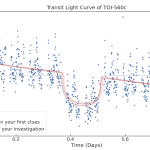
Project Gallery 2023
Secondary students from across Europe became exoplanet detectives with ESA and used Cheops satellite data to uncover the mysteries of two exoplanet targets: KELT-3b and TOI-560c.
Explore the projects below.
Abyss Watchers
Best Project Prize Winner
První soukromé jazykové gymnázium Hradec Králové – královéhradecký kraj Czech Republic 17 years old 2 /
TOI-560c
TOI-560c project description:
The Abyss Watchers’ project is divided into three main sections.
Firstly, Introduction – a section where the team itself is introduced and where we define terms that will be used throughout the whole project. Some methods of discovering new exoplanets are also described in this section.
Secondly, Our calculations – a section which focused on four of the five assigned tasks during the hackathon which mainly included mathematical calculations. In this section, we calculate the TOI 560c’s radius, orbital period, distance from its home star, mass, volume, density and orbital velocity. Albeit our correct methods, the agencies’ values were sometimes a bit different mainly due to the fact that they had first-rate access to their own advanced scientific research and archive data. Despite these factors influencing the final results, the discrepancies between our and the agencies’ values were not too significant and some were even little to none.
Lastly, Additional information – a section which focused primarily on the last task, that is figuring out the exoplanet’s composition. As very few calculations were done in this section, it became a discussion which provided sufficient arguments to its claims. However, we were not happy with just describing TOI 560c and wanted to delve deeper. Thus we also included the TOI 560 star and its entire system, which led to very interesting and noteworthy conclusions.
The main result of our work is a PDF file made in LaTeX which was made as a scientific research paper, thoroughly divided into sections and subsections while also being as formally written as possible. The literature and sources have been provided and cited as well.
TOI-560c Results and Analysis
Radius of the planet
With the initial information about TOI 560c and its star already provided by the Cheops satellite, it was not too difficult to start our own calculations. Using the transit light curve of TOI 560c, we were able to calculate its radius. The reason for this is that the depth of the exoplanet transit is equivalent to the ratio of the area of the planet’s disc and the are of the star’s disc. By measuring the transit’s depth and knowing the stellar radius, we could determine the exoplanet’s ratio, considering lower and upper errors, to be in between 16594km and 16697km. Albeit our correct calculations, the Allesfitter program provided different results. This discrepancy could be caused either by rounding up some values in our calculations or by the fact that the Allesfitter might’ve used a different method from ours.
Orbital period and distance from home star
From the archive of observations by Cheops, the orbital period of TOI 560c should be 18.8797 (in units of days). Using Kepler’s third law, we were able to calculate the distance between TOI 560c and its home star. The result which we got is 0.1249 au (astronomical units) which is a discrepancy of only 0.0007 au from the table value provided by Allesfitter. This was seen as a huge success on our part.
Mass, volume and density
Unfortunately, it is impossible to calculate the planet’s mass using the transit method, but other methods like radial velocity allow us to do so. Taking this value from the table, we get the value of 9.7 (in units of mass of Earths). To calculate the volume of the exoplanet, we assumed that it has a perfectly spherical shape, allowing us to use the standard formula for the volume of a sphere. The value we got was 1.47247 * 10^22 m^3. If both the mass and the volume of the planet are known, we can use easily calculate density. Considering the upper and lower errors, we estimate the planet’s density to be in range of 3.244 g * cm^-3 and 4.664 g * cm^-3. For further calculations and discussion, we used the value of approximately 3.9 g * cm^-3.
Orbital velocity
In order to calculate the velocity of TOI 560c, we first needed to calculate its angular velocity. The result was that the angular velocity of TOI 560c is 3.8519 * 10^-6 rad * s^-1. Afterwards, we simply multiplied this value by the distance between TOI 560c and its star and got the orbital velocity of 71.994 km * s^-1.
Planetary composition
Although it is impossible to be entirely sure about the elemental composition of TOI 560c, there is plenty of leads that give us a hint as to what it could be. For example, the dependency of the planet’s radius on its mass suggests that the planet is below pure water composition. There are therefore two most probable outcomes. Either the planet is mostly composed of water ice and silicates or it has Earth-like interior and volatile hydrogen envelope with helium being present as well. As shown by the insolation graph, TOI 560c lies way above the so called “radius valley”. This also supports the idea that the planet possesses a volatile envelope.
TOI-560c Conclusions
To conclude, the information provided by CHEOPS allowed us to create the transit light curve of TOI-560c, deduce its orbital period and distance from its home star, calculate its mass, volume, density and orbital velocity. In spite of successfully describing the basic characteristics of TOI- 560c, we wanted to dig deeper not only into information about this planet specifically, but also into information about its home star and the system in general. Everything is explained in the uploaded PDF file. We would highly encourage conducting further spectroscopy on both exoplanets of TOI-560 system as more research could be conducted afterwards.
Supporting files:



